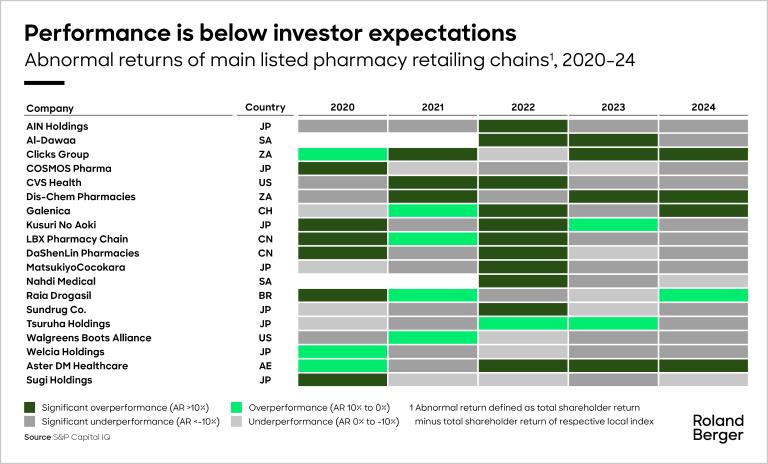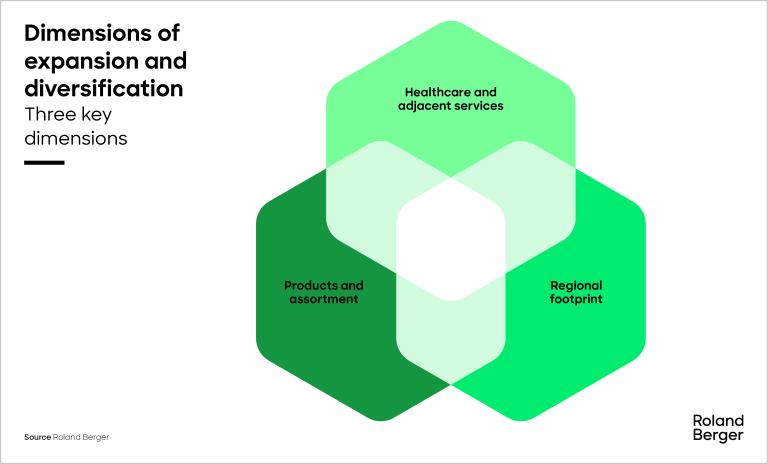The study on ESG in pharmaceuticals reveals gaps in social criteria compliance despite increasing regulatory pressures. Roland Berger categorized companies into three maturity levels—initiators, aspirers, and frontrunners—and identified key areas for improvement, such as access to medicines. The findings stress the need for broader engagement in social issues to enhance overall ESG performance.


Strategic imperatives for pharmacy retailers in disruptive times
Staying competitive and innovating in a perfect storm
The global pharmacy retail sector is undergoing a profound transformation. With a projected compound annual growth rate (CAGR) of four percent through 2029, underlying markets are steadily expanding. However, regional and product segment-related dynamics vary significantly, and the number of independent pharmacies is declining in most markets. One of the main drivers of this consolidation is the rise of pharmacy chains, which are professionalizing the retailing of drugs and adjacent categories in many markets. At the same time, consumer preferences are shifting towards standardized, digitally integrated retail experiences, and governments are actively supporting the expansion of chains.

In a new study by Roland Berger, we investigate the key forces reshaping the pharmacy retail sector and outline the strategic imperatives that will define long-term success. How are leading players adapting to demographic shifts, increased competition and the need to diversify? How successfully are they embracing digital opportunities and technologies? And what will it take for them to stay ahead in an increasingly complex and competitive environment?
Pharmacy retail at a turning point
Despite strong fundamentals, the pharmacy market is facing major challenges. Independent pharmacies in particular are up against the wall, with nearly one in five retail pharmacies in the United States having closed between 2010 and 2021, and independents’ market share in China down from two-thirds in 2010 to just 40 percent today. But the large stock market-listed pharmacy players are not immune to the challenges either: Despite strong performance during COVID-19, most listed pharmacy retailers have underperformed local indices, raising investor concerns about resilience and strategy. To stay relevant, pharmacy retailers must proactively rethink their strategy, redefine their role, differentiate their offering, exploit technology across the value chain and pursue new revenue through diversified services.
"Pharmacy retailing continues to deliver healthy margins, but they've become a magnet for new competition. Scale alone no longer suffices - the path to investor confidence lies in bold moves of differentiation."
Key market trends – and how pharmacy retailers are responding
Four pivotal trends are reshaping the retail pharmacy market. The first is demographic change: GenZ and other younger consumers expect seamless, personalized experiences , while aging populations and the rising prevalence of chronic diseases require better-integrated healthcare services. At the same time, middle-class growth in emerging markets is boosting demand for more wellness- and beauty-oriented offers. Expanding urban centers – especially in South Asia, the Middle East and Sub-Saharan Africa – are also driving demand for accessible, service-oriented care.
Second, increased competition and commoditization of the core business are putting pharmacy retailers under pressure from discounters, supermarkets and digital-first players offering broader assortments and lower prices. Despite relatively strong EBITDA margins of 8 to 12 percent, the sector is becoming more price-driven, making differentiation increasingly difficult. To stay competitive, retailers are doubling down on operational efficiency, expanding private labels and investing in loyalty programs to build customer relationships and defend their relevance.
Third, expansion and diversification strategies are becoming central to pharmacy retailers’ growth plans – ranging from broader product assortments and entry into new geographies to a larger role in healthcare and related services. Increasingly, this extends to marketplace models and direct health offerings such as diagnostics, clinics and digital or telemedicine services. These moves aim to unlock new revenue streams and position pharmacies as integral players in the evolving healthcare ecosystem.
"Pharmacy retailers need to choose in which technologies they want to lead and align that with the overall company and customer experience strategy."
Finally, technology and digitalization are transforming pharmacy retailing by driving both customer-facing innovation and back-end efficiency. Retailers are embedding AI, automation and data analytics across the value chain to improve personalization, logistics and decision-making. At the same time, digital infrastructure is opening new revenue streams through retail media networks and data-driven marketing.
A strategic health check for pharmacy retailers
To help pharmacy retailers evaluate whether their current strategy is aligned with today’s realities and prepared for tomorrow’s demands, we have designed a set of structured questions – a “strategic health check” – to identify gaps, risks and areas lacking focus. These five areas serve as practical lenses through which to assess readiness, resilience and relevance.
Register now to access the full publication and explore how pharmacy retailers adapt strategies for sustainable growth. Furthermore, you get regular news and updates directly in your inbox.











